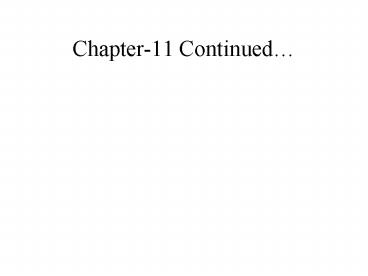Chapter-11 Continued PowerPoint PPT Presentation
Title: Chapter-11 Continued
1
Chapter-11 Continued
2
11.4 Pressure Gauges
Pressure gauges are used to measure pressures.
3
Tire pressure gauge
4
Atmospheric pressure is measured with a mercury
barometer.
5
Blood pressure is measured with a
sphygmomanometer.
6
Gauge Pressure
- Gauge pressure is the pressure measured by a
pressure gauge. - It is the difference between the absolute
pressure and atmospheric pressure. - Gauge pressure
- Absolute pressure - atmospheric pressure
7
Atmospheric Pressure
Atmospheric pressure at sea level is 1.013 105
Pa, which is sufficient to crumple a can if the
inside air is pumped out.
8
Mercury Barometer
9
Mercury Barometer
At sea level, Height of mercury h 76 cm.
Atmospheric pressure 76 cm of Hg. (76 cm 760
mm 29.9 inch)
10
Blood pressure is measured with a
sphygmomanometer.
Pressure at the peak of the beating cycle-
Systolic. Pressure at the low point of the
beating cycle- Diastolic.
For a young, healthy heart Systolic pressure
120 mm of Hg Diastolic pressure 80 mm of Hg
11
11.5 Pascal's Principle
Any change in the pressure applied to a
completely enclosed fluid is transmitted
undiminished to all parts of the fluid and the
enclosing walls.
12
Car Brakes
13
Hydraulic Car Lift
14
Archimedes of Syracuse (287BC-212BC)
Much of Archimedes fame comes from his
relationship with Hiero, the king of Syracuse,
and Gelon, Hiero's son. At one time, the king
ordered a gold crown and gave the goldsmith the
exact amount of gold to make it. When Hiero
received it, the crown had the correct weight but
the monarch suspected that some silver had been
used instead of the gold. Since he could not
prove it, he brought the problem to Archimedes.
15
Eureka
One day while considering the question, "the wise
one" entered his bathtub and recognized that the
amount of water that overflowed the tub was
proportional the amount of his body that was
submerged. This observation is now known as
Archimedes' Principle and gave him the means to
solve the problem. He was so excited that he ran
naked through the streets of Syracuse shouting
"Eureka! eureka!" (I have found it!). The
fraudulent goldsmith was brought to justice.
16
Buoyant Force
17
11.6 Archimedes' Principle
Any fluid applies a buoyant force to an object
that is partially or completely immersed in it
the magnitude of the buoyant force equals the
weight of the fluid that the object displaces
18
Derivation
Consider a cylinder of height h is being held
under the surface of a liquid.
19
Derivation
Consider a cylinder of height h is being held
under the surface of a liquid.
The fluid applies a downward force P1A to the top
face of the submerged cylinder and an upward
force P2A to the bottom face.
20
Derivation
Consider a cylinder of height h is being held
under the surface of a liquid.
The fluid applies a downward force P1A to the top
face of the submerged cylinder and an upward
force P2A to the bottom face.
21
Derivation
Consider a cylinder of height h is being held
under the surface of a liquid.
The fluid applies a downward force P1A to the top
face of the submerged cylinder and an upward
force P2A to the bottom face.

